English
Castellano
CatalÃ
Morphology of the tracks
Author: GRINPACH
Content by courtesy of : Grupo de Investigaciones Paleontológicas de Chile
Translation : MineralTown.com
Reproduction of text and photos prohibited without permission of author.
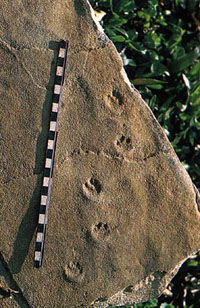
The fossil tracks or paleoicnitos (from Greek ikhnos = tracks and paleo = old), are the marks left by diverse animals in the mud and that the environmental conditions have allowed their preservation, by million years in the geologic layers, leaving a rich information on the dynamism of the animals that produced them.
In order to know as a track is generated, we are going to put an example in we ourself. Let us suppose that we ourself we wanted to leave testimony of our step, leaving our own tracks. In order to make our assignment we needed to look for a place in where the land is dampened, or, a pool, the border of some lake or the creek of some river. First we must verify if this muddy land has the sufficiently argillaceous consistency to mark our feet, because if the mud is too humid the track was become deformed, because when raising our foot, the mud adhered to him will rise, on the contrary if the land is very dry will not have the sufficient plasticity to leave our mark, therefore we needed neither a very humid nor very dry, single land thus we will be able to leave our feet noticeable. But this is not all, after leaving the tracks, these must be dried with the environmental heat and soon to be protected, that is, to be covered by other sediments to prevent that natural agents destroy them like the wind, the water, the ice or the passage of other animals over these. If our tracks have been able to draw for these obstacles, then we will have a future fossil track.
Also we must consider the weight of the animal that produces the track, since the consistency of the mud is not equal for different animals, for example, in an apt mud to leave the tracks of an elephant, perhaps, is not adapted to leave the tracks of a rodent noticeable because the corporal mass is different.
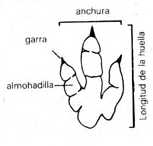
The tracks left by a biped or quadruped vertebrate, will depend on the conservation. When in the layers it appears a single track, this delivery little information, we can know through this if the animal that produced it had bearings or no, number of fingers in the leg, if it had claws, the size of the leg, in the case of the dinosaurios if he were teropode or sauropode.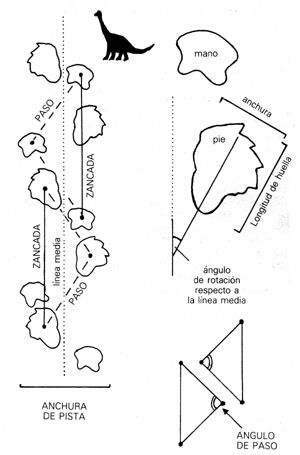
Other type is set of tracks denominated rakeful that is step continued of animal on mud, since by the nature of these they can give the same information to us of the isolated track, plus the contribution of knowing how if this animal ran or walked slowly, to deduce his speed, if it produced some change in the direction of his to walk, if he were quadruped or biped, etc.
MORPHOLOGY OF THE TRACK
In an isolated track we can write down the length and the wide one of the track, the angle of traverse of the leg, the depth of the track, number of fingers, morphologic structure, presence of bearings, length of the fingers and the claws.
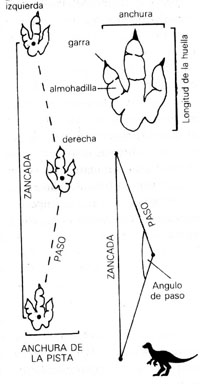
In a set of tracks or rakefuls in addition to the previous one we can write down the angle of the step that is possible to determine it through three consecutive tracks, we can see the length of the step, the length of the stride, the width of the track, the mean line or light, that are the distance between the tracks of the left and right side, direction of movement, if he were quadruped or biped, so large of the hands with respect to the legs, if he were plantigrade or digitigrade, that is if one leaned in the fingers or all the leg.
If the track is wide it indicates us that the track it could produce an animal that had its legs to the sides of the body, as in the case of the lizards, whereas if the tracks parallel and are continued they demonstrate that they belong to an animal to walk biped like for example dinosaur or hominid, therefore in this one case the light of the rakeful is minimum and the pitch angle much more is extended.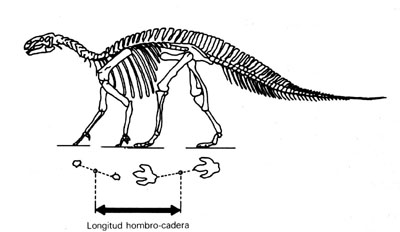
Also we have other characteristics in the tracks since some facultative animals are biped this means that sometimes they walk in four extremities and others in two, as it is the case of the Iguanodonts, also we can obtain the approximate dimensions of a quadruped animal obtaining the length of the shoulder to the hip, from the distance between the midpoints of the distances of the previous and later extremities.
Content by courtesy of :
Information | Mineral photos | VIDEOS | Articles | Fairs | Web directory | Classified ads | Minerals Books | Shop



